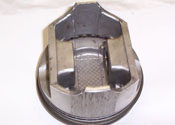Four Corner Piston Scuffing on Automotive Gasoline Engines

The AERA Technical Committee offers the following information to consider, while examining four-corner piston scuffing failures on automotive gasoline engines. This condition may be present on one or any number of pistons within an engine.
The piston shown in the photos below indicates "four-corner"scuffing of the skirts. An extremely high abnormal combustion temperature causes this type of failure. Those hot temperatures travel down the piston and concentrate in the pin area. As that area of casting continues to heat up, it also increases in diameter. If the temperature is high enough, the piston will eventually exceed the bore size in diameter in that area only and cause the scuffing. Pistons are generally .020-.030" smaller in diameter in that area before the engine is started. The scuffing occurs after the piston expands beyond its designed limits, caused by excessive temperature.
The key is finding the root cause of this abnormal combustion temperature before reinstalling the engine. If the cause of the failure is not repaired, the same failure will occur again.
Listed below are things you should know when engine components are machined to the standards of service criteria published by AERA.

Pistons were the correct size because all were measured. Piston Cylinders were the correct size, straight and round.
Piston to wall clearance was correct as per piston manufacturer specifications.
The cylinder wall finish was correct for piston rings supplied.
Wrist pin clearance was correct as per piston manufacturer specifications.
Assembled correctly by the technician / machinist.

Things you may not know if you did not do the installation:
Cooling system was bled down properly and adequately.Piston
Air / Fuel ratio measured not just at idle but also under load at road speed.
Ignition timing set correctly for all rpm's.
EGR functioning at road speed, not just in the garage.
Engines with previously failed head gasket make sure that the oxygen
sensor is new.

Was the correct heat range of spark plug installed.
See Engine Component Failure Analysis booklet # 20400001-12-04
The AERA Technical Committee